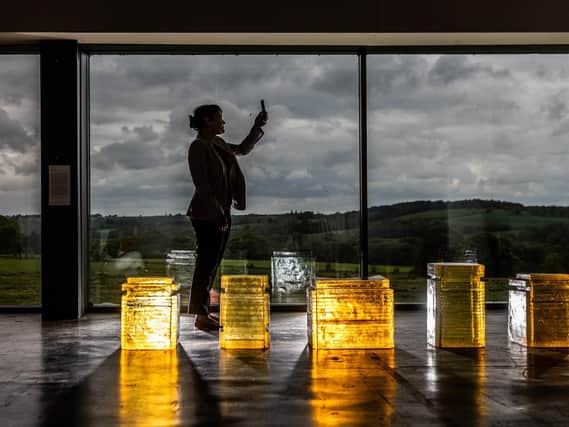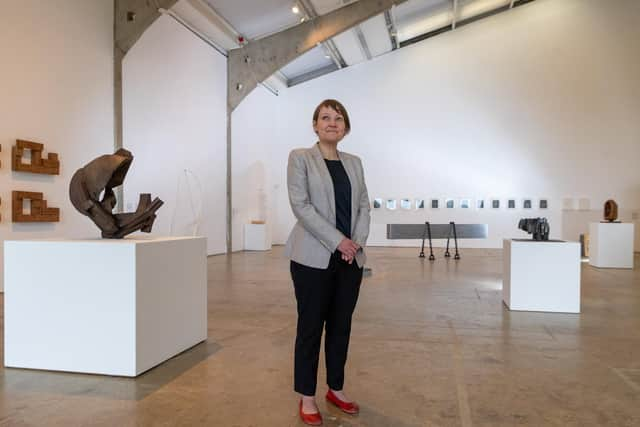Yorkshire Sculpture Park celebrates work of female sculptors like Barbara Hepworth in new exhibition


It is true to say that in many areas of activity, women have often been side-lined from the bigger picture. This is particularly the case in art history which has frequently airbrushed the achievements and influence of women artists, and an exhibition which recently opened at the Yorkshire Sculpture Park’s Longside Gallery aims to redress the balance.
Breaking the Mould: Sculpture by Women since 1945 is the first extensive survey in a public gallery of post-war British sculpture by women. It spans more than 70 years and explores the work of 50 sculptors including Phyllida Barlow, Elisabeth Frink, Barbara Hepworth Cornelia Parker, Sarah Lucas, Rachel Whiteread and Alison Wilding.
Advertisement
Hide AdAdvertisement
Hide AdThe show is part of the Arts Council Collection’s 75th anniversary celebrations and is a deliberately restorative act, designed to inspire future generations of women artists. It was initiated in response to a research project – Women Working in Sculpture from 1960 to the Present Day: Towards a New Lexicon – carried out by Catherine George of the University of Coventry and independent curator Hilary Gresty.


“Catherine and Hilary received some funding from the Henry Moore Foundation to interview 30 contemporary women artists to find out about their experiences of working in sculpture.
They came to us with their research findings and suggested that we put on an exhibition,” says Natalie Rudd, senior curator of the Arts Council Collection who curated the YSP exhibition.
“In the collection we have more than 250 works by over 150 women – we have this incredible resource spanning around 75 years, so we thought it was a good idea.”
Advertisement
Hide AdAdvertisement
Hide AdSculpture has traditionally in the past been considered a male domain and many of the works on display are by artists who have challenged this notion by embracing new materials, subjects or approaches, pushing at the boundaries of what sculpture is and can be. The artworks range from large-scale pieces to installations and smaller-scale works using diverse materials such as ceramic, hair, paper, flowers and salt.
“Historically there has been quite a lot of exclusion or marginalisation of women in the art world generally,” says Rudd. “In sculpture some of it has grown out of post-war British attitudes towards the making of sculpture as a ‘sleeves rolled up’ activity – the idea of it as a kind of physical labour.
Critics found it hard to write about artists like Barbara Hepworth who did not get the attention or the column inches that Henry Moore did even though they were contemporaries. There was a lot of sexism around how many women artists featured in galleries and exhibitions and over time many of them became invisible.”
Hepworth spoke out on this as early as in the 1930s and 40s and as her career began to take off, she was able to pave the way and show other women artists what was possible.
Advertisement
Hide AdAdvertisement
Hide Ad“We did think hard about whether we should do a women-only exhibition, because we didn’t want to replace one fixed narrative with another,” says Rudd. “But we felt it was right because we had so many wonderful works by women and we wanted to get that work out there to prompt a conversation. Neither did we want it to be a fixed show – we will be loaning this exhibition and developing it and it will be touring to other venues. It will continue to grow because we are always acquiring new works.”
Rather than displaying the sculptures in a strictly chronological order, they have been arranged around three key themes – Figured, Formed and Found. “It means that you might get a
Hepworth sculpture alongside a piece from an emerging young artist, for example, or a work by an established contemporary artist like Rachel Whiteread alongside a new acquisition and viewers will be able to see the influences playing out across the gallery space.”
Selecting what to include in the exhibition must have been quite a challenge, given the range of works to choose from in the collection.
Advertisement
Hide AdAdvertisement
Hide Ad“It was really hard,” says Rudd. “We had print-outs of all the works and looked through them carefully. Some had been on loan or been seen very recently so they were excluded – there was a fairness in our selection. We wanted to show the scale and range of works – so we have everything from the large-scale to the tiny and delicate. We had this range of practice and then we built up ideas around that, thinking about which pieces would create a conversation around these three themes. We wanted to put the work of new sculptors next to household names. And there were some artists who we didn’t know very much about such as Emma Park who we really wanted to include. Also, we wanted to be as generous as we could with our collection.”
The exhibition offers the opportunity to see several works that have not been on public display for a while as well as some on show in public for the first time including Rose Finn-Kelcey’s God’s Bog 2013, a toilet cast in Jesmonite curling like a delicate seashell as well as Katie Cuddon’s A Problem of Departure, 2013, a ceramic sculpture that suggests a pillow clasped between dimpled thighs.
“That piece has been acquired very recently,” says. “Katie Cuddon’s work is always so ambiguous – it could be a vulnerable figure or a sexual encounter that we are looking at. She uses clay like language, she is talking with her materials. There are works of older or deceased artists. We have the work of Shelagh Cluett who was working mostly in the 1970s and 80s but we bought some pieces of hers, beautiful flowing sculptures, last year. One of the aims for the exhibition is also to enable more research into some of the lesser-known artists.”
One of the strong themes emerging from the exhibition, says Rudd, is the idea of overcoming adversity. That is not only in terms of representation but also in the way in which some of the work has been created. “Making sculpture can be very expensive,” she says.
Advertisement
Hide AdAdvertisement
Hide Ad“And artists that are emerging or struggling to afford resources have chosen cheap materials to work with or they are deliberately using what might be thought of as ‘feminine’ materials to make a point.”
Examples that immediately spring to mind are Sarah Lucas’s amazing sculptures made out of stuffed tights – there is one in the show – or the work of Portuguese artist Joanna Vasconcelos who uses domestic objects such as saucepans to make her large-scale sculptures (also currently on display at YSP).
“What is interesting is how limitations have sometimes led to creative responses,” says Rudd.
“The contribution of women artists in terms of bringing new materials that can be used in sculpture has been significant and long-lasting. Putting the exhibition together has felt like a responsibility but it has also felt quite playful, seeing how the sculptures work together and ‘speak’ to each other. There is something round each corner to surprise you.”